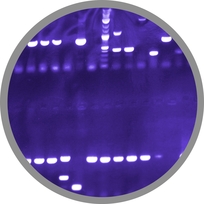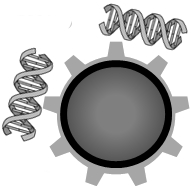Team:LMU-Munich/Application
From 2012.igem.org
| Line 4: | Line 4: | ||
| - | What are the potential '''advantages''' of using | + | What are the potential '''advantages''' of using ''B. subtilis'' spores as functional bioparticals? |
<br>They are | <br>They are | ||
{| | {| | ||
| Line 22: | Line 22: | ||
|} | |} | ||
| - | <p align="justify">There are many possible applications for our [https://2012.igem.org/Team:LMU-Munich/Spore_Coat_Proteins '''Sporo'''beads], as it is possible to display all kinds of different proteins on their surface. To easily create | + | <p align="justify">There are many possible applications for our [https://2012.igem.org/Team:LMU-Munich/Spore_Coat_Proteins '''Sporo'''beads], as it is possible to display all kinds of different proteins on their surface. To easily create them, we designed a [https://2012.igem.org/Team:LMU-Munich/Bacillus_BioBricks/Sporovector '''Sporo'''vector] where you just have to insert the gene encoding your fusion protein of choice.</p> |
| - | + | ||
| - | + | ||
| - | + | ||
| - | </p> | + | |
| - | <br>'''Kumamolisin'''-'''Sporo'''beads: the solution for carefree enjoyment of everyday meals | + | <br>'''Kumamolisin'''-'''Sporo'''beads: the solution for carefree enjoyment of everyday meals for Coeliac disease! |
<br> | <br> | ||
[[File:LMU-Munich-spore-Gluten_cutting.jpg|left]] | [[File:LMU-Munich-spore-Gluten_cutting.jpg|left]] | ||
<p align="justify"> | <p align="justify"> | ||
| - | World-wide, one out of [http://www.enriquecastro.net/index.php/term/,9da4ab975b545ba0ae53646c58a5a265aa5d535892a89b979fa4b1a49297a261a260555c5a.xhtml 3350] people cannot eat meals that contain wheat products or other foods with traces of gluten. This disease is known as | + | World-wide, one out of [http://www.enriquecastro.net/index.php/term/,9da4ab975b545ba0ae53646c58a5a265aa5d535892a89b979fa4b1a49297a261a260555c5a.xhtml 3350] people cannot eat meals that contain wheat products or other foods with traces of gluten. This disease is known as Coeliac disease. Kumamolisin is an [http://partsregistry.org/wiki/index.php?title=Part:BBa_K590087 enzyme] that cleaves peptides and was produced by the iGEM-Team from the University of [https://2011.igem.org/Team:Washington Washington] last year. The substrate includes a specific sequence of amino acids, which causes Coeliac disease in sensitive people when they consume food containing gluten. Our beads could carry Kumamolisin as a secure vehicle for the passage to the stomach, so that the enzyme can work properly where it is needed. The [https://2012.igem.org/Team:LMU-Munich/Germination_Stop <b>Germination</b>STOP] we integrated in our spores would prevent outgrowth and ensure a correct dosage. This project is a pharmaceutical application and therefore would have to fulfill the legal requirements for pharmaceuticals. This includes several verification steps of non-toxicity and efficacy. [Security] |
</p> | </p> | ||
| - | '''CPX'''-'''Sporo'''beads: rescuing | + | '''CPX'''-'''Sporo'''beads: rescuing the ocean from human debris! |
<br> | <br> | ||
[[File:LMU-Munich-spore-Plastic_binding.jpg|left]] | [[File:LMU-Munich-spore-Plastic_binding.jpg|left]] | ||
<p align="justify"> | <p align="justify"> | ||
| - | The excessive use of disposable plastic and the lack of universal recycling programs has led to the pollution of the world's oceans. In the ocean, large pieces of Polystyrene litter are ground by sea currents into very small pieces, so called | + | The excessive use of disposable plastic and the lack of universal recycling programs has led to the pollution of the world's oceans. In the ocean, large pieces of Polystyrene litter are ground by sea currents into very small pieces, so called plastic plancton, that are consumed by fish, filter feeders, and other organisms living in the oceans. Such plastic uptake can lead to poisoning, sterility and death. The [http://partsregistry.org/wiki/index.php/Part:BBa_I728500 CPX-peptide] can bind to Polystyrene and was generated by the iGEM team from MIT (2007). CPX-'''Sporo'''beads in huge filter boxes could be put into place to mechanically filter microscopic plastic particles, like polystyrene plancton, out of the water. To prevent the beads from being released into the sea and the plastic to be kept, the '''Sporo'''beads could be attached to membranes in the boxes. Then the '''Sporo'''beads would need to not only display CPX but also a membrane binding protein on their surface. [security] |
</p> | </p> | ||
| - | '''TALE'''-'''Sporo'''beads: easy and cheap detection of genetically modified organisms | + | '''TALE'''-'''Sporo'''beads: easy and cheap detection of genetically modified organisms! |
<br> | <br> | ||
[[File:LMU-Munich-spore-Dna_binding.jpg|left]] | [[File:LMU-Munich-spore-Dna_binding.jpg|left]] | ||
<p align="justify"> | <p align="justify"> | ||
| - | Since 1990, green biotechnology releases many transgenic plants into the environment by selling genetically modified seeds. Thus organic farmers need to prove | + | Since 1990, green biotechnology releases many transgenic plants into the environment by selling genetically modified seeds. Thus, organic farmers need to prove that their products meet the requirements for organic crops. Usually they pay laboratories to attest the lack of contamination with genetically modified crops. New tools for sequence-specific DNA-binding of molecular biology, TAL effectors, combined with our '''Sporo'''beads could be an easy and cheap solution for organic agriculture. Farmers could use a kit with TALE-''lacZ''-'''Sporo'''beads to detect sequences specific for GM-crops. As spores are stable and safe vehicles, they could be send by mail without any considerations. The kit would be suitable for use outside of laboratory. The protocol for this could work as follows: |
| - | <br>DNA extracted from plants with solutions provided by the kit is immobilized and fixed on a nitrocellulose membrane. This membrane is then washed, incubated with '''Sporo'''beads in solution and washed again. With addition of a substrate, the | + | <br>DNA extracted from plants with solutions provided by the kit is immobilized and fixed on a nitrocellulose membrane. This membrane is then washed, incubated with '''Sporo'''beads in solution and washed again. With addition of a substrate, the surface displayed LacZ of bound '''Sporo'''beads will catalyze a reaction so that a blue staining appears. If no such DNA is present, the spores will not bind and no blue color will appear.</p> |
Revision as of 01:00, 27 September 2012

The LMU-Munich team is exuberantly happy about the great success at the World Championship Jamboree in Boston. Our project Beadzillus finished 4th and won the prize for the "Best Wiki" (with Slovenia) and "Best New Application Project".
[ more news ]

Application
What are the potential advantages of using B. subtilis spores as functional bioparticals?
They are
| easy and cheap to produce in large quantities (check out the link to this commertialoffer) | |
| very stable even under severe environmental conditions | |
| unable to proliferate and therefore most likely not treated as genetically modified organisms by the law | |
| part of human nutrition in terms of food supplements and generally regarded as safe [GRAS] |
There are many possible applications for our Sporobeads, as it is possible to display all kinds of different proteins on their surface. To easily create them, we designed a Sporovector where you just have to insert the gene encoding your fusion protein of choice.
Kumamolisin-Sporobeads: the solution for carefree enjoyment of everyday meals for Coeliac disease!
World-wide, one out of 3350 people cannot eat meals that contain wheat products or other foods with traces of gluten. This disease is known as Coeliac disease. Kumamolisin is an enzyme that cleaves peptides and was produced by the iGEM-Team from the University of Washington last year. The substrate includes a specific sequence of amino acids, which causes Coeliac disease in sensitive people when they consume food containing gluten. Our beads could carry Kumamolisin as a secure vehicle for the passage to the stomach, so that the enzyme can work properly where it is needed. The GerminationSTOP we integrated in our spores would prevent outgrowth and ensure a correct dosage. This project is a pharmaceutical application and therefore would have to fulfill the legal requirements for pharmaceuticals. This includes several verification steps of non-toxicity and efficacy. [Security]
CPX-Sporobeads: rescuing the ocean from human debris!
The excessive use of disposable plastic and the lack of universal recycling programs has led to the pollution of the world's oceans. In the ocean, large pieces of Polystyrene litter are ground by sea currents into very small pieces, so called plastic plancton, that are consumed by fish, filter feeders, and other organisms living in the oceans. Such plastic uptake can lead to poisoning, sterility and death. The CPX-peptide can bind to Polystyrene and was generated by the iGEM team from MIT (2007). CPX-Sporobeads in huge filter boxes could be put into place to mechanically filter microscopic plastic particles, like polystyrene plancton, out of the water. To prevent the beads from being released into the sea and the plastic to be kept, the Sporobeads could be attached to membranes in the boxes. Then the Sporobeads would need to not only display CPX but also a membrane binding protein on their surface. [security]
TALE-Sporobeads: easy and cheap detection of genetically modified organisms!
Since 1990, green biotechnology releases many transgenic plants into the environment by selling genetically modified seeds. Thus, organic farmers need to prove that their products meet the requirements for organic crops. Usually they pay laboratories to attest the lack of contamination with genetically modified crops. New tools for sequence-specific DNA-binding of molecular biology, TAL effectors, combined with our Sporobeads could be an easy and cheap solution for organic agriculture. Farmers could use a kit with TALE-lacZ-Sporobeads to detect sequences specific for GM-crops. As spores are stable and safe vehicles, they could be send by mail without any considerations. The kit would be suitable for use outside of laboratory. The protocol for this could work as follows:
DNA extracted from plants with solutions provided by the kit is immobilized and fixed on a nitrocellulose membrane. This membrane is then washed, incubated with Sporobeads in solution and washed again. With addition of a substrate, the surface displayed LacZ of bound Sporobeads will catalyze a reaction so that a blue staining appears. If no such DNA is present, the spores will not bind and no blue color will appear.
 "
"










